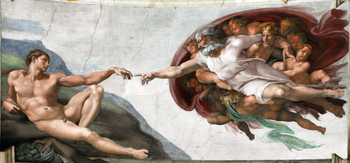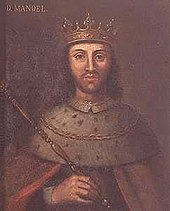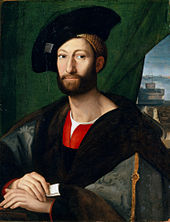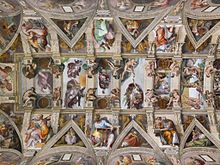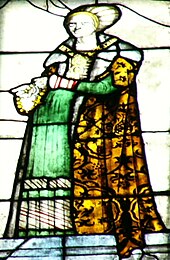1512
Portal history | Portal Biographies | Current events | Annual calendar
◄ |
15th century |
16th century
| 17th century
| ►
◄ |
1480s |
1490s |
1500s |
1510s
| 1520s
| 1530s
| 1540s
| ►
◄◄ |
◄ |
1508 |
1509 |
1510 |
1511 |
1512
| 1513
| 1514
| 1515
| 1516
| ►
|►►
| 1512 | |
|---|---|
| Emperor Maximilian I divides the Holy Roman Empire into ten imperial circles . | Selim I becomes Sultan of the Ottoman Empire . |
|
Michelangelo Buonarotti's ceiling paintings in the Sistine Chapel are unveiled. |
|
| 1512 in other calendars | |
| Armenian calendar | 960/961 (turn of the year July) |
| Ethiopian calendar | 1504/05 |
| Aztec calendar | 6th tubes - Chicuace Acatl (until the end of January / beginning of February: 5th rabbit - Macuilli Tochtli ) |
| Buddhist calendar | 2055/56 (southern Buddhism); 2054/55 (alternative calculation according to Buddhas Parinirvana ) |
| Chinese calendar | 70th (71st) cycle
Year of the water monkey壬申 ( at the beginning of the year metal sheep 辛未) |
| Chula Sakarat (Siam, Myanmar) / Dai calendar (Vietnam) | 874/875 (turn of the year April) |
| Dangun era (Korea) | 3845/46 (October 2/3) |
| Iranian calendar | 890/891 |
| Islamic calendar | 917/918 (turn of the year 18/19 March) |
| Jewish calendar | 5272/73 (September 10-11) |
| Coptic calendar | 1228/29 |
| Malayalam calendar | 687/688 |
| Seleucid era | Babylon: 1822/23 (turn of the year April)
Syria: 1823/24 (turn of the year October) |
| Spanish era | 1550 |
| Vikram Sambat (Nepalese Calendar) | 1568/69 (turn of the year April) |

The year 1512 brought another imperial reform by Emperor Maximilian I , who divided the Holy Roman Empire into ten imperial circles for better administration by the imperial regiment, a division that lasted until the empire fell in 1806 . In the course of an imperial reform , Emperor Maximilian I divided the Holy Roman Empire into ten imperial circles , 1560. Despite a victory in the Battle of Ravenna , France had to withdraw from northern Italy , which gave the Medici the opportunity to return to Florence as ruler , and the Sforza to return to Milan . In the meantime, the confederates have become a regional power.
In the Ottoman Empire there was a change of the throne: Selim I deposed his father Bayezid II , who died a little later under unexplained circumstances, as sultan and took over rule.
Outside of Europe, the colonial powers Portugal and Spain continue to divide the world among themselves and consolidate their rule in their respective empires through legal regulations and the armed suppression of resistance.
The cultural highlight of the year is the unveiling of Michelangelo Buonarotti's ceiling painting in the Sistine Chapel in the presence of the client Pope Julius II , who in the same year opened the fifth Lateran Council , the aim of which is again a church reform.
Events
Politics and world events
Spanish empire
- February 2 : Taíno chief Hatuey is captured and executed by the Spaniards under Governor Diego Velázquez de Cuéllar in Cuba after a brief resistance fight .
- As the successor of the Feb. 22 deceased Amerigo Vespucci is Juan Díaz de Solís for piloto mayor of the Casa de Contratación appointed. He is primarily responsible for updating the Padrón Real , the map on which all new discoveries are recorded.
- July: King John III. and his wife Catherine are expelled from the Kingdom of Navarre by Fadrique Álvarez de Toledo, 2nd Duke of Alba on behalf of Ferdinand II of Aragon and León-Castile in a campaign lasting only two weeks and have to move to the small part of the empire north of the Pyrenees withdraw. Navarre is incorporated into the Kingdom of Spain and administered by a viceroy .
- December 27 : Derecho Indiano : In the Leyes de Burgos , Spain legally regulates the dealings with the indigenous population in the New World . The new law requires their participation in catechesis , outlaws bigamy and reserves the monopoly of force for Spanish officials. Originally, the laws were limited to the island of Hispaniola , but will soon be extended to the other Spanish colonies .
Portuguese Empire
- The Portuguese navigator António de Abreu , in search of the Spice Islands from Portuguese India , was the first European to reach the island of Timor , which is divided into several small independent kingdoms ( Kerajaan ), as well as the islands of Solor and Alor . The Portuguese Timor colony will be established here over the next few years .
- The Portuguese Francisco Serrão forms an alliance with the Sultan of Ternate , whose personal advisor he becomes. The following year the Portuguese were allowed to set up a trading post on the island.
- Portuguese conquer the Indian city of Surat , which belongs to the Sultanate of Delhi , sack it and burn it down.
- King Manuel I of Portugal issues a "regimento" regarding the allied Kingdom of the Congo under King Afonso I , which states that the Portuguese should assist the Mani-Congo in organizing his empire, including the establishment of a legal system based on the European model of an army. Missionary engagement, support in building churches and teaching the court Portuguese etiquette are also planned, in return the Congo is supposed to fill the Portuguese ships with valuable cargo, especially slaves, ivory and copper.
- The edict of Manuel I from 1497 , with which the religious persecution of the Marranos is prohibited, is extended. Nevertheless, the situation of the forcibly baptized Jews in Portugal is noticeably worsening .
- around 1512: António de Abreu reaches the Banda Islands .
Italian Wars / Holy League
In the course of the Italian wars with Habsburg for hegemony in Europe, French troops under the command of Gaston de Foix , Duke of Nemours , invade Romagna and Veneto in February . France wants to wrest control of these regions from the Holy League, which was founded last year . The French conquer several cities, including Brescia being sacked on a lasting basis. Gaston de Foix knows that the invasion of France threatened by King Henry VIII of England will require a large part of his army to be relocated to France. Therefore, he tries to force the opponent to a decisive battle beforehand. At the end of March, the French march eastwards from Bologna with Alfonso I d'Este , Duke of Ferrara, and begin the siege of Ravenna , which is defended by papal troops. Alerted by the danger of losing his last fortress in Romagna, Pope Julius II demands and receives an army that, under the command of Ramón de Cardona , the Spanish viceroy of Naples , sets out to liberate the city.
On April 11th it comes to the decisive battle. The army of the Holy League is defeated by the French in the Battle of Ravenna , but Gaston de Foix is killed in the battle. The complete victory of the French does not help to secure northern Italy, but rather they must withdraw from the region in August.
After several unsuccessful attempts in the years before, Giano di Campofregoso succeeded with the help of his relative Ottaviano in driving their Ghibelline opponents, namely the Adorno family, from Genoa . Giano was appointed Doge of the Republic of Genoa on June 29th . Antoniotto Adorno subsequently made a pact with the French King Louis XII. to regain power in the Maritime Republic .
The Medici returned to Florence on August 31st with Spanish help . The republican city government under Piero Soderini had previously put up strong resistance, which was only given up after the city of Prato was captured and sacked on August 29 . A parliamento is convened and a balia is formed that abolishes the Gran Consiglio of the Republic and introduces a constitution similar to that of Lorenzo il Magnifico . Giuliano di Lorenzo de 'Medici and his brother Giovanni de facto become masters of the city, but for the most part refrain from taking revenge. Only the current State Secretary of the Republic and closest confidante of the fled Soderini, Niccolò Machiavelli , is relieved of his office in November and has to deliver a guarantee for future good conduct amounting to five times his previous annual salary, an obligation that he can only fulfill with the support of friends.
Swiss travelers force Massimiliano Sforza to move into Milan on December 15 and officially appoint him as Duke on December 29 . In return, he had to cede the towns of Lugano , Locarno , Mendrisio , the Valle Maggia and the domination of Domodossola to the Confederates . The Bündner get the Valtellina , the Grafschaft Cläven and the Herrschaft Worms . Furthermore, the Swiss demand a one-off payment of 200,000 ducats and then annual payments of 40,000 ducats. The Pope lets Parma and Piacenza occupy under the pretext of old feudal rights .
The naval battle of Saint Mathieu on August 10th is the first naval battle in which cannons are used on special gun decks. The battle between an English and a French- Breton fleet off the Breton coast near Brest ends in a draw, but the largest French warship to date, Marie la Cordelière, and the largest English warship, Regent, are sunk. The French captain Hervé de Portzmoguer dies along with nearly 1,600 French and English sailors and marines.
Holy Roman Empire
In the course of a further imperial reform , Emperor Maximilian I divided the Holy Roman Empire into 10 imperial circles at the Reichstag in Trier in order to enable better administration of the empire by the imperial regiment. In addition to the six imperial circles that have existed since 1500, there are also the Burgundian Empire , the Austrian Empire , the Upper Saxon Empire and the Kurrheinische Reichskreis . There are also numerous territories and estates not circled in the Holy Roman Empire , including the territories in Imperial Italy , the countries of the Bohemian Crown and the territories of the Old Confederation . The imperial circles existed until the empire was dissolved in 1806 .
- January 30th : After the death of his father Reinhard IV , Philip II becomes Count of Hanau-Munzenberg .
- May 21 : Following the death of Pandolfo Petrucci , the Sienese elders, bound by a secret treaty signed five years earlier, declare obedience to his eldest son Borghese Petrucci and transfer their father's power as head of the Signoria to him.
- June 18 : Eitel Friedrich III. becomes after the death of his father Eitel Friedrich II. Count of Hohenzollern .
- October 8th : Maximilian I draws up a Reichsnotariatsordnung , the effect of which, however, remains low due to the decline of the Reich authority.
- At Heldrungen the construction of the moated castle of the fortress Heldrungen begins. The structure was completed in 1519 .
- The places Hahn (as Hain ), Hardt (as Hart ), Hönde (as Honde ) and Hürxtal (as Hovericheß Dal ) are first mentioned in a document.
Denmark / Hanseatic League
The peace of Malmo pulls on April 23 the line under the Danish-Hanseatic War of 1510 and 1511 between the other cities of the Wendish towns League allied Lübeck and Denmark . In the peace that Lübeck's mayor Thomas von Wickede was looking for, when it became clear that no clear winner was to be expected in the even war, the Hanseatic League had to tolerate Dutch trade with Denmark in the future.
Sweden
The Swedish ruler Svante Sture dies on January 2nd . The clergyman Erik Trolle is elected as his successor by the Imperial Council. But the election is challenged by Svante's son Sten Sture the Younger , who is ultimately elected as imperial administrator in a new ballot . Erik Trolle then withdrew from active policy on the Reich.
Eastern Europe
- Russo-Lithuanian Wars : The relationship between the personal union Poland-Lithuania and the Grand Duchy of Moscow remained tense even after the peace treaty of 1508. When the Moscow Grand Duke Vasily III. When the news of the alleged arrest of his sister Elena reaches him, he opens war against King Sigismund in order to forestall a renewed cooperation between Poland-Lithuania and the Crimean Tatars . On November 14th , Moscow advance detachments were set on the march against Smolensk ; on December 19, the Grand Duke personally joined the advancing troops with his entourage.
Ottoman Empire
Selim I , called Yavuz “the rigors”, deposed his father Bayezid II as sultan on April 24th and took over rule in the Ottoman Empire . Under his rule, the empire's rise to world power continued. Bayezid withdraws to Dimotika , but dies on May 26 under unknown circumstances on the journey. Selim's first act as ruler is the order to execute his brothers and all his nephews, a procedure that has been institutionalized in the Ottoman Empire since Mehmed II . In order not to force his son Suleyman to do the same thing later, he refrains from any further contact with his wives.
Asia
- As the last of the five Deccan sultanates , Golkonda gains independence from the Bahmani Sultanate . The capital of the new sultanate is initially Golkonda .
- The Khiva Khanate in Khorezmia is founded after the population has thrown an army of the Persian Safavids out of the country. The main cities of the khanate are Urgensch and Khiva . Although the first Khan Ilbars belongs to the Scheibanid family, relations with the neighboring Uzbek khanate , also ruled by the Scheibanids, are strained.
economy
- The oldest known Zurich thaler is minted.
science and technology
- December 6th : The Nikolaischule , the first secular school in Leipzig , is inaugurated.
- The Portuguese pharmacist Damiano de Odemira publishes his bilingual chess textbook Questo libro e da imparare giocare a scachi et de le partite in Rome . The work, in which expanded train options for the runner and the new figure of the lady are presented, will spread throughout Europe over the next few decades .
- Parma is the famous nautical atlas of the Visconte Maggiolo made.
Culture
| Culture | |
|---|---|
|
literature
- The Swiss Glarean receives because of a Lobgedichtes to Emperor Maximilian I of this the poet crown as poet laureate .
- The medieval verse epic Orendel is published for the first time in Augsburg. A prose version will also appear at the same time.
Visual arts
architecture
- In the Hessian town of Marburg , the construction of the new town hall in late Gothic style begins under foreman Klaus von Wetzlar .
painting
After more than four years of work, Michelangelo Buonarotti's ceiling painting in the Sistine Chapel is ceremoniously unveiled on November 1st in the presence of the client, Pope Julius II . They show scenes from Genesis on a total of 520 m² with 115 larger-than-life characters. In particular, the fresco The Creation of Adam becomes one of the most famous works in art history.
- The master of the Prenzlauer high altar completes his work.
- Raphael begins on behalf of Pope Julius II on the occasion of the incorporation of the city of Piacenza into the Papal States after the victory over the French in the previous year with the work Sistine Madonna for the high altar of the monastery church of San Sisto in Piacenza .
religion
- May 10 : The fifth Lateran Council convened on April 19 by Pope Julius II begins. 15 cardinals and 79 bishops take part in the opening session, almost all of them Italians. First, the council goes to the disempowerment of the previous year by the French King Louis XII. convened counter-council of Pisa , which it condemns as schismatic.
- from June: After the Holy Skirt was shown to Emperor Maximilian on the occasion of his presence in Trier at the Reichstag , it is shown in several presentations to the people at their loud request. Until 1517 there are annual pilgrimages and "demonstrations" in Trier, after that at irregular longer intervals.
- July 5th : The church of St. Zeno in Reichenhall falls victim to a devastating fire. During the subsequent renovation, extensive gothic work was carried out .
- November 15th : Emery d'Amboise dies. Guy de Blanchefort succeeds him as Grand Master of the Order of St. John .
Disasters
- September 30th : A landslide of Monte Crenone in the Ticino Valle di Blenio (Blenio Valley) kills several hundred people. They are buried under rock masses in the northern part of the village of Biasca .
- The Hanseatic city of Lünen burned down almost completely in a large fire.
Historical maps, views and documents

Born
Date of birth saved
- January 15 : Robert IV. De La Marck , Duke of Bouillon and Lord of Sedan († 1556 )
- January 31 : Henry I , called "the Cardinal King", King of Portugal , the last of the Avis family ; Cardinal and Archbishop of Lisbon († 1580 )
- March 5 : Gerhard Mercator , Flemish-German mathematician, geographer, philosopher, theologian and cartographer († 1594 )
- April 10 : James V , King of Scotland († 1542 )
- April 30 : Georg II , Duke of Münsterberg and Oels († 1553 )
- June 22nd : Daniel von Büren the Younger , Mayor of Bremen († 1593 )
- June 23 : Johann Fichard , Frankfurt lawyer († 1581 )
- June 24th : Balthasar Brusch , Eger bookbinder, bookseller and chronicler († 1589 )
- July 1 : Johanna von Pfalz-Simmern , abbess at Marienberg Monastery († 1581 )
- July 5 : Cristoforo Madruzzo , Italian cardinal († 1578 )
- July 17th : Sibylle von Jülich-Kleve-Berg , eldest daughter of Duke Johann III. († 1554 )
- July 25 : Diego de Covarrubias y Leyva , Spanish church lawyer and humanist († 1577 )
- August 27 : Friedrich Staphylus , German theologian († 1564 )
- October 26 : Bartholomew VI. Welser , Augsburg patrician († 1546 )
- December 4 : Jeronimo Zurita , Spanish historian († 1580 )
- December 25 : Stephan Riccius , German Protestant theologian († 1588 )
Exact date of birth unknown
- Galeazzo Alessi , Italian architect († 1572 )
- Edward Clinton , English admiral († 1585 )
- Martin Cromer , Polish historian, theologian and bishop ( 1589 )
- Prospero Fontana , Italian Renaissance painter († 1597 )
- Devlet I. Giray , Khan of the Crimea († 1577 )
- Urs Graf the Younger , Swiss goldsmith and rice walker († 1559 )
- Thomas Grynaeus , Württemberg theologian and reformer († 1564 )
- Volkmar Wolf von Hohnstein , Regent of the County of Hohnstein († 1580 )
- Johannes Holl , Augsburg renaissance builder († 1594 )
- Joachim Lüneburg , Mayor of Lübeck († 1588 )
- Fernando Vázquez de Menchaca , Spanish lawyer and humanist († 1569 )
- Hilmar von Münchhausen , German mercenary leader († 1573 )
- John Parkhurst , Bishop of Norwich († 1575 )
- Catherine Parr , Queen of England, last wife of Henry VIII († 1548 )
- Mikołaj Radziwiłł Rudy , Lithuanian Grand Chancellor and Grand Hetman, leading exponent of Calvinism in Lithuania († 1584 )
- Melchor Bravo de Saravia , Spanish lawyer and politician († 1577 )
- Pontus de Tyard , French poet and theologian († 1605 )
- Rodrigo de Quiroga López de Ulloa , Spanish conquistador and governor of Chile († 1580 )
Died
First half of the year
- January 2 : Svante Sture , Swedish general and imperial administrator (* around 1460 )
- January 30th : Reinhard IV. , Co-regent of the County of Hanau-Münzenberg (* 1473 )
- February 2nd : Hatuey , chief of the Taino
- February 9 : Bernardino Fernández de Velasco y Mendoza , Spanish military leader and politician (* 1454 )
- February 12 : Burkhart Engelberg , Augsburg stonemason and master builder (* 1447 )
- February 15 : Matthias Scheit , Bishop of Seckau (* 1440 )
- February 22nd : Amerigo Vespucci , Florentine merchant, navigator and seafarer, namesake of America (* 1454 )
- February 23 : Sigismondo de 'Conti , Italian humanist, historian and papal secretary (* 1432 )
- March 29 : Lucas Watzenrode , Prince-Bishop of Warmia (* 1447 )
- before April 6: Giovanni Marinoni , Italian painter (* around 1455 )
- April 8th : Margarete von Braunschweig-Lüneburg , Duchess of Mecklenburg-Stargard (* 1442 )
- April 11 : Gaston de Foix , French general, Duke of Nemours (* 1489 )
- April 24th : Nikolosa Bursa , Benedictine and abbess of the monastery on the Venetian San Servolo
- May 21 : Pandolfo Petrucci , tyrant of the Republic of Siena (* 1452 )
- May 26 : Bayezid II , Sultan of the Ottoman Empire and poet (* 1447 )
- June 18 : Eitel Friedrich II. , Count of Hohenzollern (* 1452 )
Second half of the year
- July 11th : Hartmann Feierabend , federal clergyman and humanist, founder of the Badische Stiftsbibliothek (* around 1450)
- July 17 : Pallas Spangel , Catholic priest, theologian and rector of the University of Heidelberg, also advisor to the Elector and Vice Chancellor of the Palatinate (* around 1445 )
- August 2 : Alessandro Achillini , Italian philosopher and doctor (* 1463 )
- August 10 : Hervé de Portzmoguer , Breton nobleman and naval officer (* between 1473 and 1478)
- August 15 : Imperia Cognati , Roman courtesan (* 1486 )
- before August 29th : Georg Krafft , red and brass caster and gunsmith from Kurmainz
- September 10th : Heinrich Castorp , businessman, councilor and mayor of the Hanseatic city of Lübeck
- September 15 : John Stewart, 1st Earl of Atholl , Scottish nobleman (* around 1440 )
- September 29th : Johannes Engel , Bavarian physician, astronomer / astrologer, physicist and mathematician (* 1463 )
- October 5 : Sofia Jagiellonka , Margravine of Brandenburg-Kulmbach and Brandenburg-Ansbach (* 1464 )
- October 31 : Anna of Saxony , Electress of Brandenburg (* 1437 )
- November 11th : Wolfgang von Polheim , Austrian nobleman (* 1458 )
- November 13 : Emery d'Amboise , Grand Master of the Order of St. John
Exact date of death unknown
- John Brooke, 7th Baron Cobham , English nobleman
- Gonçalo Coelho , Portuguese explorer (* around 1451 )
- Olivier van Ghent , Flemish sculptor (* 1470 )
- Dietrich Gresemund , German humanist author (* 1477 )
- Nils Henriksson , Norwegian nobleman and large landowner (* 1455 )
- Ludwig Vergenhans , German lawyer, cleric and diplomat (* around 1425 / 30 )
Died around 1512
- Hieronymus Brunschwig , German doctor and author (* around 1450 )
- Francesc Vicent , Valencian chess author (* around 1450 )


